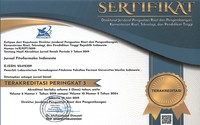Pengaruh Tempat Tumbuh dan Lama Penyulingan secara Hidrodestilasi terhadap Rendemen dan Profil Kandungan Kimia Minyak Atsiri Daun Kemangi (Ocimum canum Sims L.)
Abstract
Full Text:
PDF (Bahasa Indonesia)References
Dacosta, M., Sudirga, S. K. & Muksin , I. K. 2017. Perbandingan Kandungan Minyak Atsiri Tanaman Sereh Wangi (Cymbopogon nardus L, Rendle) yang Ditanaman di Lokasi Berbeda. Jurnal Simbiosis V, 5, 25-31.
Guenther, E. 1990. Minyak Atsiri Jilid IV B, Jakarta, UI-Press.
Haris, R. 1987. Tanaman Minyak Atsiri, Jakarta, Penebar Swadaya.
Hendrawati & Eka, R. A. 2010. Uji Toksisitas Akut Ekstrak Etanol Daun Kemangi (Ocimum sanctum Linn.)Terhadap Larva Artemia salina Leach Dengan Metode Brine Shrimp Lethality Test (BST). Skripsi, Universitas Diponegoro.
Khajiamiri 2010. Identifikasi Senyawa Aktif menggunakan GC-MS berdasarkan keputusan Wiley and NIST Library. USA.
Marwat, S. K., Rehman, F. U., Khan, S. M., Ghulam, S., Anwar, N., Mustafa, G. & Usman, K. 2011. Phytochemical Constituents and Pharmacological Activities of Sweet Basil Ocinum basilicum L (Lamiaceae). Asian Journal of Chemistry, 23, 3773-3782.
Muchtaridi, M. 1996. Penelitian Pengembangan Minyak Atsiri sebagai Aroma Terapi dan Potensinya sebagai Produk Sediaan Farmasi.
Negoro, A. M. 2007. Penentuan metode terbaik proses penyulingan minyak atsiri daun sirih [Piper betle linn.] antara penyulingan dengan air dan penyulingan dengan air dan uap. Skripsi, Universitas Sanata Dharma.
Nuzulia, R. & Santoso, O. 2017. Pengaruh Ekstrak Daun Kemangi (Ocimum basilicum Linn) pada Berbagai Konsentrasi terhadap Viabilitas Bakteri Streptococcus mutans: Studi pada Mahasiswa Fakultas Kedokteran Universitas Diponegoro. Jurnal Kedokteran Diponegoro, 6, 1565-1571.
Ozcan, M. & Chalchat, J. C. 2002. Essential Oil Composition of Ocimum basilicum L.and Ocimum minimum L. in Turkey. Czech J. Food Sci, 6, 223-228.
Sastrohamidjojo, H. 2014. Kimia Minyak Atsiri, Yogyakarta, Gadjah Mada University Press.
Sulianti, S. B. 2008. Studi Fitokimia Ocimum Spp.: Komponen Kimia Minyak Atsiri Kemangi Dan Ruku-ruku (Phytochemical Study of Ocimum Spp.: Chemical Components of Essential Oils of Kemangi and Ruku-ruku). Berita Biologi LIPI, 9, 237-241.
Ulfah, D. & Karsa, A. L. 2007. Pengaruh tempat tumbuh dan lama penyulingan rendemen minyak atsiri rambu atap (Baeckea frustescens) dengan penyulingan metode perebusan. Jurnal Hutan Tropis Borneo, 08, 84-88.
DOI: https://doi.org/10.33096/jffi.v6i2.507
Copyright (c) 2019 Syamsu Nur

This work is licensed under a Creative Commons Attribution 4.0 International License.
Indexed by:
ISSN: 2356-0398 | e-ISSN: 2541-2329
Editor's Address:
Third Floor Pharmacognosy-phytochemistry laboratory building, Urip Sumoharjo road km. 5 Campus II UMI, Makassar, South Sulawesi, Indonesia
Phone: +6281524045514
Fax: +62411425619
E-mail: editorjfi@umi.ac.id

















.jpg)

